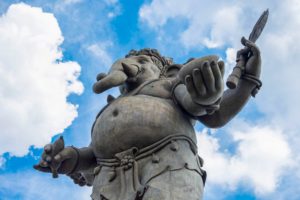Support Hidden Compass
Our articles are crafted by humans (not generative AI). Support Team Human with a contribution!
Anyone who’s set foot outside of Kabul in the past three decades has seen them: a tank here, a wheeled troop carrier there — the rusting hulks of Soviet-built armored vehicles littering roadsides like skeletons, left behind by a superpower’s defeat.
When I saw them in Wardak and Helmand provinces on my first reporting trip to Afghanistan, in the spring of 2009, I felt sure that whatever the outcome for the United States in the country that had beaten the Soviet Union in the 1980s, it couldn’t possibly look like that. I’d spent a lot of time in close quarters with the American military in Iraq, and I couldn’t imagine American troops leaving their damaged gear behind the way Soviet troops had, undignified and disorderly in their defeat.
Between 2007, when I first went to Iraq as a 19-year-old freelancer, and 2017, when I last went to Afghanistan, I made six trips to those two countries. I was there to cover the wars for different outlets and eventually to research a book about how the 20-year conflict had played out in one particular Afghan region I’d become fascinated by: the Pech Valley.
During trips to Iraq amid President George W. Bush’s surge in 2007 and 2008, I had covered the war that American infantrymen and cavalrymen were fighting against Shiite militias and the forerunners of the Islamic State. Pivoting to Afghanistan in 2009, I wanted instead to see combat advisers — the U.S. troops who weren’t fighting the Taliban themselves but helping Afghan soldiers and policemen do it.
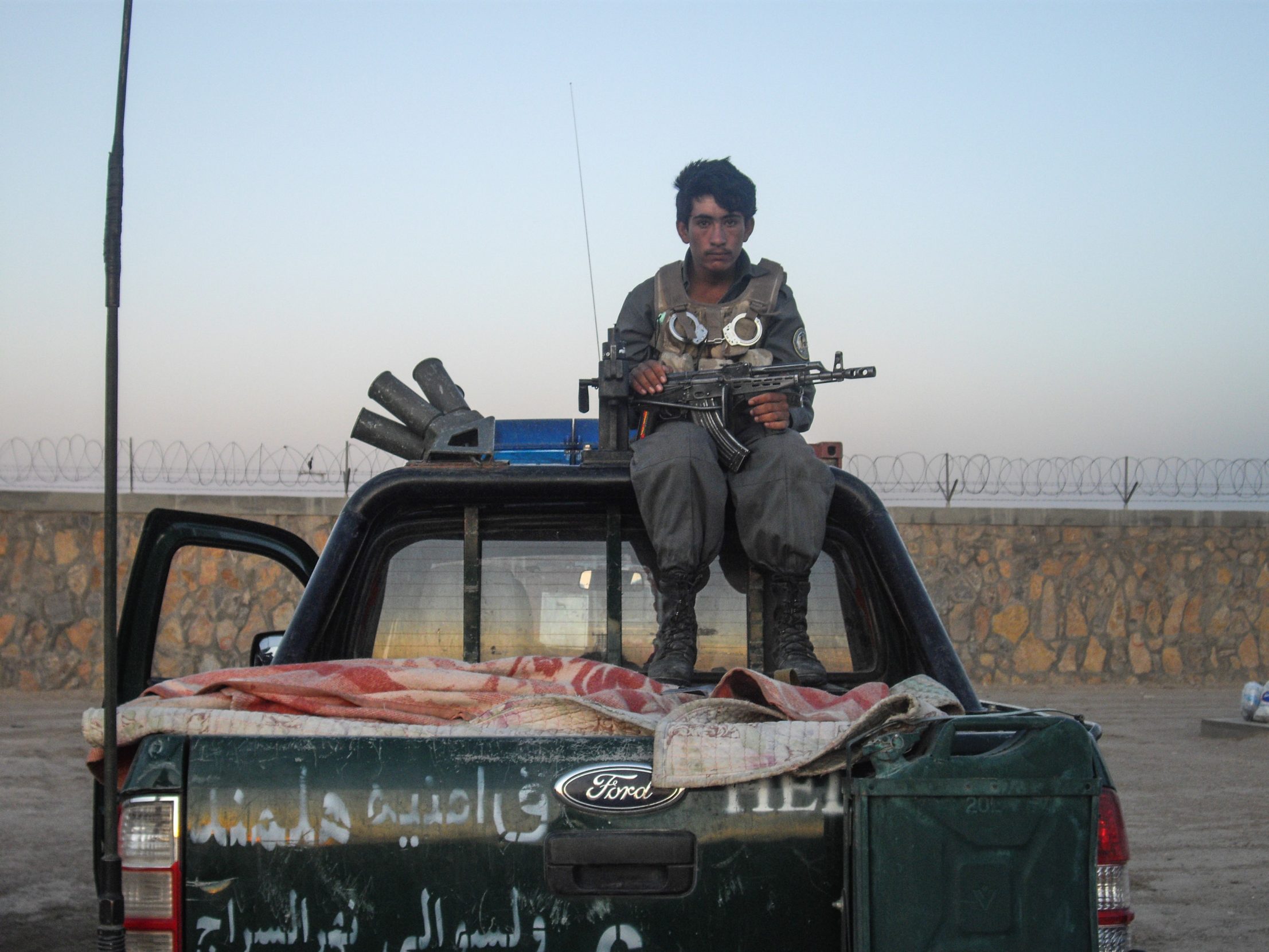
An Afghan policeman in Helmand province sits atop a Ford truck, a gun spread across his lap. In 2009, when this image was taken, the embattled southern province became the focus of President Barack Obama’s promised surge. Photo: Wesley Morgan.
I’m a writer, not a photographer, so when I took photos, they weren’t for publication but rather to jog my memory when I sat down to write about what I’d seen.
In 2008, in the restive Iraqi city of Mosul, I’d lived through an “insider attack” — an Iraqi soldier, likely an insurgent infiltrator, had turned his rifle on the cavalrymen with whom I was embedded and killed two of them. So I understood that the work of combat advisers carried its own special risks beyond those of regular combat.
But I’d grown up reading stories about Green Berets and other advisers in Vietnam, and knew that, as in that war, when the United States eventually, inevitably, withdrew, the Afghan republic’s fate would rest on the shoulders of the local troops those advisers had trained. I wanted to see how that advisory mission was faring.
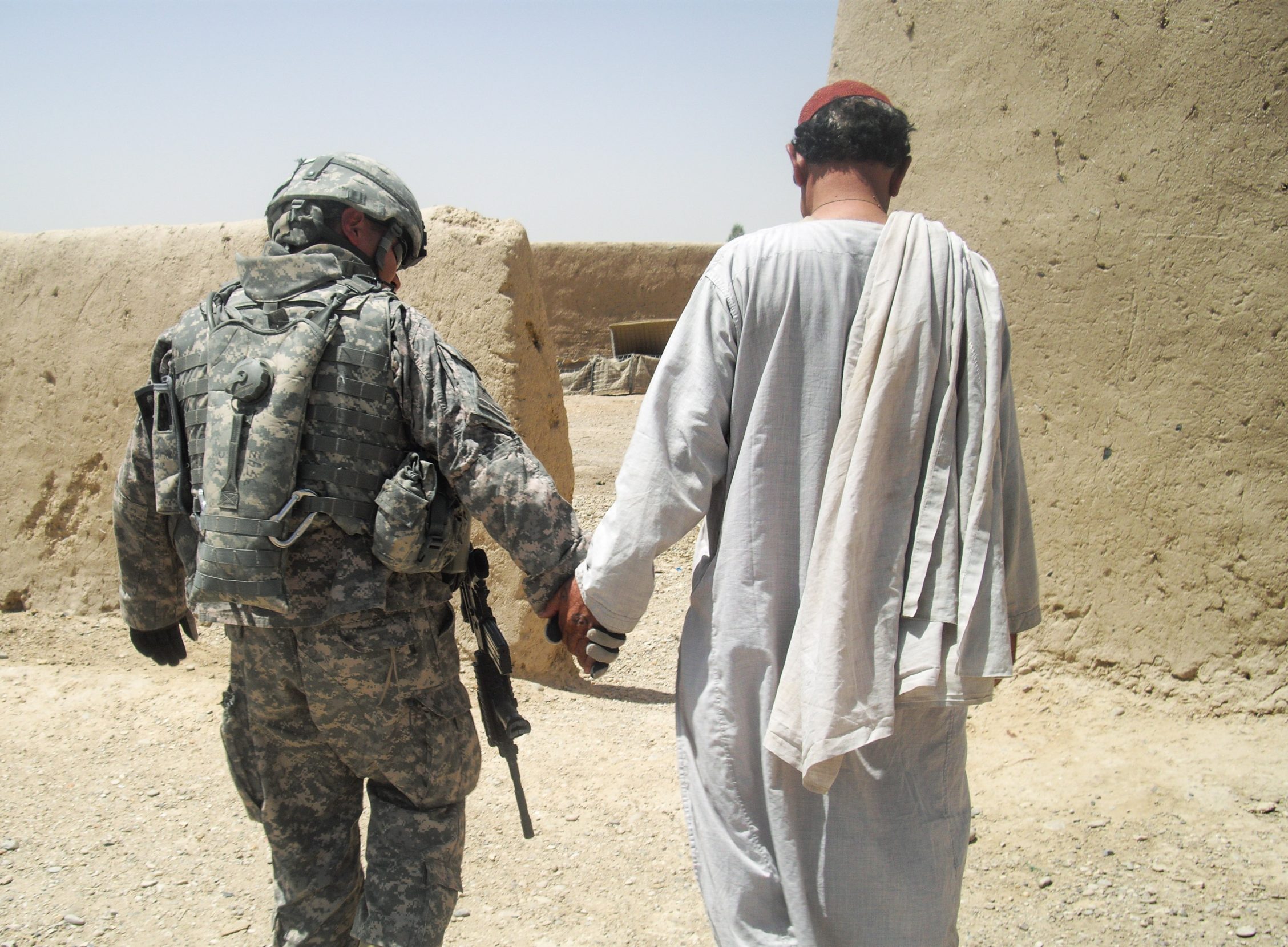
An Illinois National Guard officer and an Afghan National Policeman hold hands in Helmand on June 6, 2009. When this shot was taken, it didn’t feel like the U.S.-backed government was losing. Photo: Wesley Morgan.
~~
At a dilapidated outpost in Helmand Province’s Nad-e Ali district, code-named Yellow 13 — a series of crumbling concrete compounds ringed by lush green vegetation in which Taliban fighters lurked — policemen in their gray, Soviet bloc–style uniforms manned the ramparts with only a couple of magazines each for their rifles and barely any rounds left for their two belt-fed PKM machine guns. Their commander held up a walkie-talkie tuned to the enemy’s frequency, so that the visiting advisers and I could hear the enemy’s crackling voices.
As long as the team of Illinois National Guard police advisers I was traveling with were present, the Taliban likely wouldn’t attack, because wherever Americans went, airpower followed. The guardsmen were few in number, but they had the power to call in air strikes — as they had when they’d rushed to Yellow 13 the previous week to help it fend off an assault. Many of the advisers were cops themselves in civilian life, and their task was to check up on frontline Afghan police outposts in Helmand — an embattled southern province that was about to become the focus of the redoubled efforts in Afghanistan that Barack Obama had promised on the campaign trail.
I wanted to see the combat advisers — the U.S. troops who weren’t fighting the Taliban themselves but helping Afghan soldiers and policemen do it.
It was the spring of 2009, and more allied troops — and more airpower — were coming soon, the major in charge of the adviser team told the police commander. Before this set of buildings became a police outpost, it had been the local headquarters of a USAID development project. Among the musty papers on the floor of one cavernous room was a document marked “Helmand-Arghandab Construction Company” in English and dated August 1952 — a relic of a previous, peaceful phase of Western involvement in Afghanistan.
The Illinois Guard major reassuring the policemen at Yellow 13 knew that it was about to be subsumed into the next phase: Within a few weeks of my visit, a battalion of several hundred British troops would arrive in armored vehicles and make the police outpost their own, with new fortifications and barracks.
At the time, it didn’t feel like the U.S.-backed government was losing. Even in Helmand, the Taliban’s toughest stronghold in Afghanistan, the policemen I spoke to — beleaguered troops who often had only enough ammunition for the next firefight — seemed optimistic. Their monthly pay was arriving more reliably than it had been, thanks to mobile banking; there were new NATO training programs for them; and everyone knew that Obama’s surge meant American Marines and British troops were flowing into the province and about to go on the offensive.

ANA soldiers in 2013 man a hilltop observation post at the mouth of Kunar province’s Watapur Valley. At the time — with the big-unit war over and the renewed focus on advising seemingly bearing fruit — it was hard not to feel hopeful again. Photo: Wesley Morgan.
The signs were there, though, that even as the U.S. and NATO doubled and then tripled their troop levels in Afghanistan, soaring from 33,000 when Obama took office to 100,000 by the end of 2010, this aspect of the war — the efforts of small adviser teams to build up Afghan forces — wasn’t the one they were doubling down on. Camp Leatherneck, the big base in the Helmand desert that I visited when a batch of policemen had to convoy there to enter a training program, wasn’t filling up with more advisers. It was filling up with American and British combat units, ready and eager to take on the Taliban themselves.
The British unit that inherited Yellow 13, the Welsh Guards, would flood Nad-e Ali district not with more Afghan police outposts but with more outposts of their own — little British bubbles, manned by 20 or 40 British infantrymen, meant to shrink the area of the district in which the insurgents were able to operate.
~~
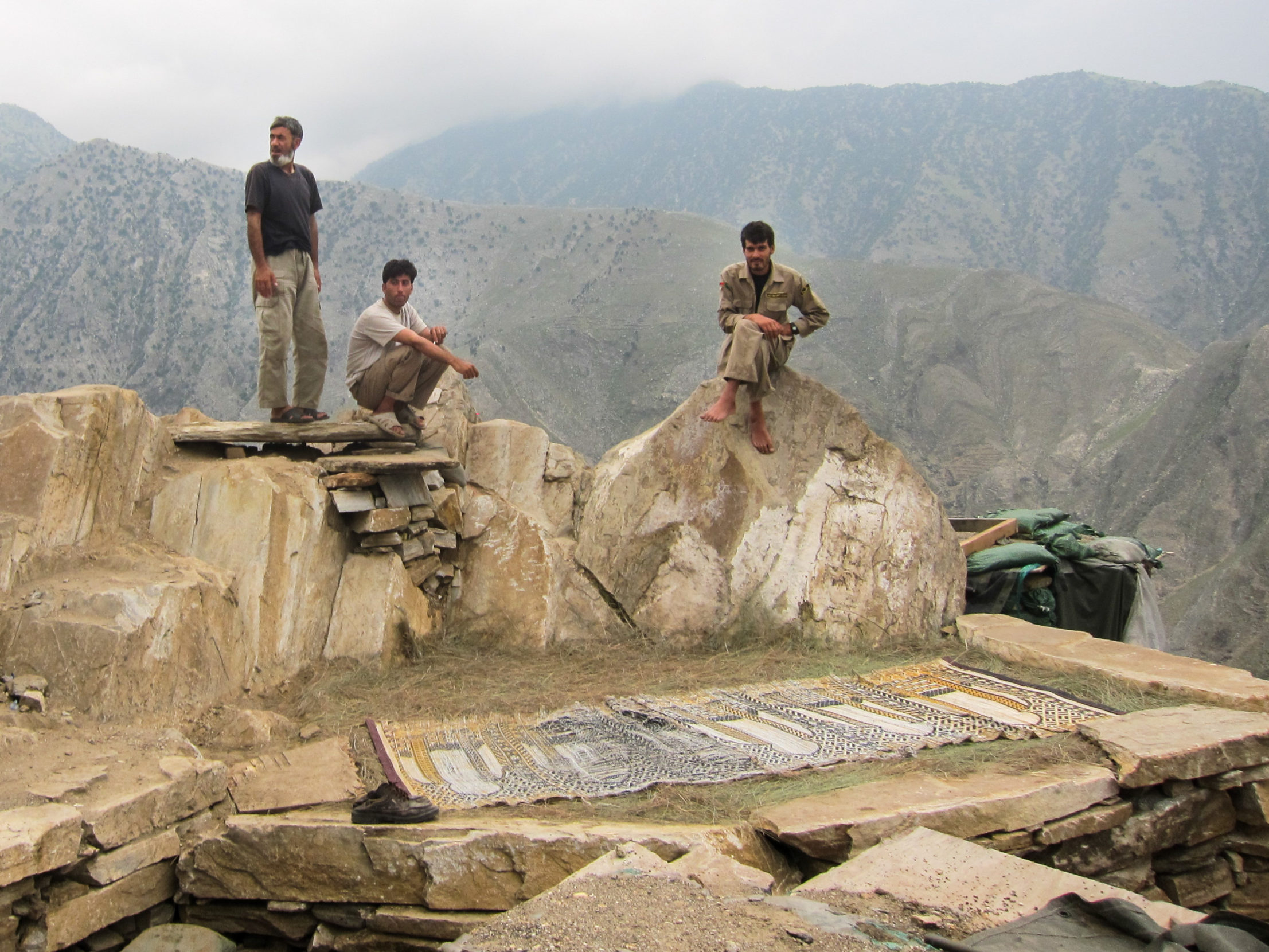
In August 2010, three Afghan security guards lounge on rocks in the craggy and treacherous Pech Valley. At the time, the U.S. and NATO were rapidly expanding the ANA — at least on paper. Photo: Wesley Morgan.
A year later, in the summer of 2010, I returned to Afghanistan for a three-month swing through several southern and eastern provinces, this time embedding not with advisers but with the infantry units that were clearly the focus of the surge, which was now in full swing. In Paktika Province, I flew in with a battalion of the 101st Airborne Division that brought a group of Afghan police along on an air-assault mission to a distant district.
Camp Leatherneck wasn’t filling up with more advisers. It was filling up with American and British combat units, ready and eager to take on the Taliban themselves.
The tactic they used was one I hadn’t seen before: Wearing balaclavas and goggles to keep the dust at bay, the policemen drove motorcycles (decorated with colorful metallic tape, like their rifles) into the bellies of the big Chinook helicopters, then drove them out again when the birds landed, acting as a scouting and screening force for the American infantrymen as they moved to their target compounds. It was a dramatic sight, but the 101st troops were using the police as little more than token auxiliaries.
Versions of this arrangement repeated themselves as I visited three more infantry battalions that summer — two American and one British — out of about 70 such battalions conducting counterinsurgency operations in Afghanistan at the time. Staying at their outposts and tagging along with them on their missions, I saw each battalion use “their” Afghan troops as token auxiliaries, typically bringing some along on patrols either to search houses or to perform some other, likely quiet, unchallenging task.
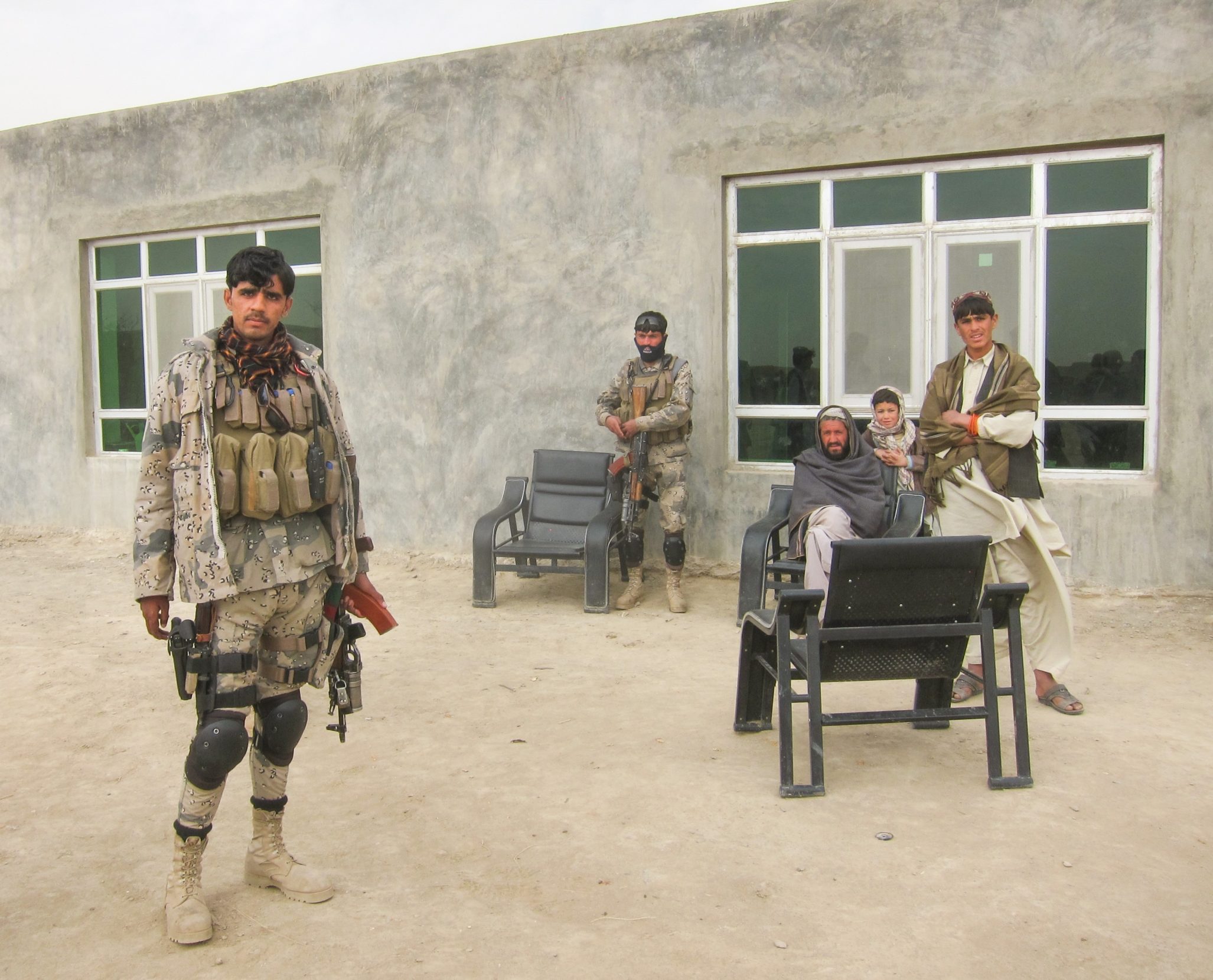
Five Afghan Border Police officers sit and stand at the ready in the Spin Boldak district of Kandahar, a province in the southern part of the country. Photo: Wesley Morgan.
In Sangin — a flat, rural district in Helmand where British troops were dying or losing limbs to IEDs on a near-daily basis — a Royal Marine unit outsourced the job of dealing with the Afghan National Army (ANA) to an attached company of Scottish infantrymen who had been divvied up into ad hoc adviser teams. But the Scots wound up acting more like leaders than advisers, rustling up a squad of Afghans for a patrol and filling in for ANA junior officers who felt it was below their station to leave the outpost for missions.
Outside the wire, the Scottish troops were able to control the movement of their ANA advisees but not their fire discipline; if an Afghan soldier thought he saw an insurgent, he would likely empty a whole magazine at him. “With them it’s one round, all their rounds, or nae rounds,” a frustrated Scottish lance corporal told me.
Wearing balaclavas and goggles, the policemen drove motorcycles — decorated with colorful metallic tape, like their rifles — into the bellies of the big Chinook helicopters, then drove them out again when the birds landed, scouting and screening for the American infantrymen.
And in Zhari, a district in the lush but heavily mined Arghandab Valley outside Kandahar, Afghan troops refused to accompany daytime patrols because of Ramadan fasting — a fact that frustrated U.S. soldiers, who weren’t allowed to mount missions without at least a few of their Afghan allies. Under a rule imposed in 2007 — meant to placate the Afghan president, who already saw how heavy-handed raids by foreign troops were inadvertently helping the Taliban build momentum — American and allied soldiers couldn’t enter and search Afghan homes unless they had Afghan government troops with them.
For most of the Army and Marine infantry battalions I saw in Afghanistan during the Obama surge, this rule was the only reason they bothered with the ANA at all. They would drag Afghan troops along as an afterthought, to satisfy the requirement to “put an Afghan face” on what were really U.S. or NATO missions.
~~
It wasn’t until later that I realized the motorcycle-helicopter dance I’d witnessed in Paktika was another example of this phenomenon. The American battalion — led by a thoughtful up-and-coming Army officer — was habituating the policemen to a tactic that would be viable only as long as American troops and aircraft were around to play their part.
The Army and Marine infantry battalions I saw in Afghanistan during the Obama surge would drag Afghan troops along as an afterthought, to satisfy the requirement to “put an Afghan face” on what were really U.S. or NATO missions.
I was guilty of a version of the same sin. In my coverage that summer I wrote only one article specifically about the ANA and its prospects. Even though I knew the Afghan troops were the ones who would win or lose the war, it was mostly the Americans and Brits who were doing the heavy lifting at that moment. And the intensity of the fighting they were engaged in was seductive for a reporter covering combat.
One of the longest-serving Afghanistan hands I know was a retired Delta Force soldier who returned to the country’s northeast over and over again as a contractor with a small counterinsurgency advising outfit — a kind of in-house consultancy whose advice U.S. headquarters often didn’t listen to. He knew that if the U.S. and NATO were going to extricate themselves from Afghanistan, the Afghan security forces needed to take on as much responsibility as soon as they could. Foreign troops would have to play a supporting role.
“The way out was to put them in the front and make them responsible,” he said. But not one of the many U.S. battalions he saw rotate through the northeast over many years did this. “They’d just take some ANA along because it was mandated to be a joint operation,” he told me. “That was theater-wide.”
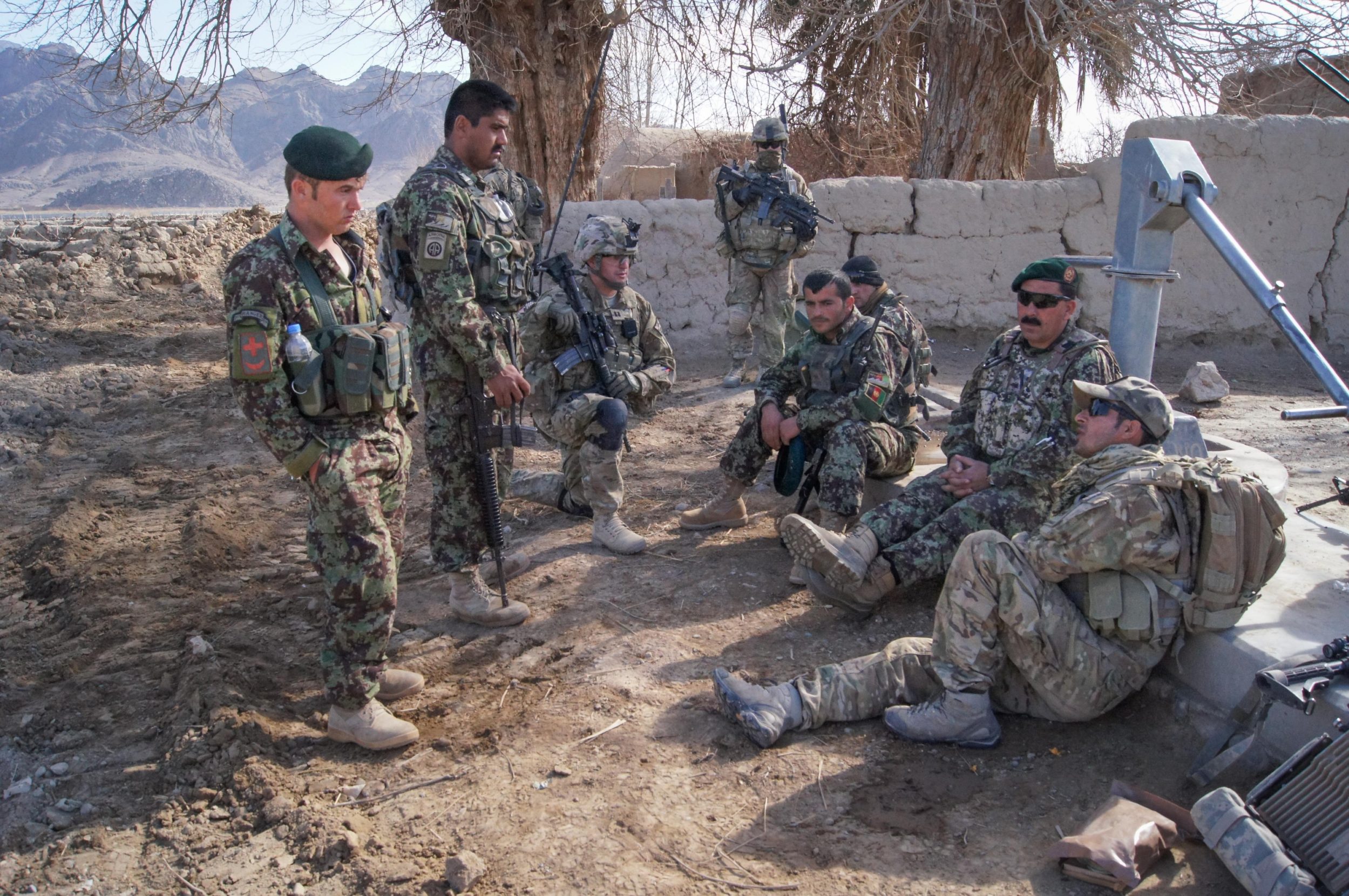
U.S. and Afghan soldiers share a moment of repose during a village-clearing mission in the Zhari district of Kandahar province. Photo: Wesley Morgan.
Brett Jenkinson — a retired colonel who spent a year commanding a U.S. infantry battalion in a mountainous province where Afghan troops were especially reliant on their American allies for artillery support and helicopter resupply — admitted to me that he lost sight of the importance of preparing the ANA to stand alone.
“I lost interest and lost patience in the train-advise-assist mission,” said Brett Jenkinson, a retired colonel who spent a year commanding a U.S. infantry battalion in a mountainous province. “I shouldn’t have, because that’s our ticket out.”
Jenkinson’s ANA counterpart was a middle-of-the-road bureaucrat — an uninspiring leader who avoided danger and seemed to care little about the welfare of his men. Jenkinson, who found this maddening, avoided dealing with him unless he absolutely had to — an approach that his own subordinate commanders took their cues from.
“I lost interest and lost patience in the train-advise-assist mission,” Jenkinson told me with regret. He’d returned to Afghanistan much later in the war as an adviser and seen how little progress the ANA had made — in part because of attitudes like those he’d exhibited his first time around.
“I shouldn’t have,” he said, “because that’s our ticket out.”
~~
In concert with the surge, the U.S. and NATO were rapidly expanding the ANA, injecting it with tens of thousands of fresh recruits in order to create new units that could accompany the freshly deployed American ones that were spreading out into ever-more-remote districts. Just 90,000 strong in early 2009, the ANA numbered 140,000 by the summer of 2010 — at least on paper. The Afghan battalion in Zhari was a newly minted one, heavy on soldiers fresh out of basic training but with few officers and sergeants to lead them.
“They got thrown into the fire without a whole lot of collective training,” said one sympathetic U.S. captain in Zhari, whom I’d met previously when he was working as an adviser to Iraqi troops in Baghdad. “Learning while at the same time doing combat operations is very tough.”
When I returned to Zhari on another trip in 2013, the approach still seemed mostly the same, just with larger numbers of Afghan troops. U.S. commanders planned big operations, like clearing whole villages, then told the ANA (maybe a battalion by now, when in 2010 it would’ve been a company) about their role shortly before execution.
An ANA battalion commander I photographed on one such operation personified the heavy U.S. influence on his fledgling army: standing amid his troops, holding a can of nonalcoholic beer, while they looked for IEDs.
“They got thrown into the fire without a whole lot of collective training,” said one sympathetic U.S. captain in Zhari. “Learning while at the same time doing combat operations is very tough.”
The first time I visited ANA units on their own, without embedding with their American advisers, was in Kunar later in 2013, as the role of those advisers was winding down. (It would ramp back up again later in some parts of the country during the mini-surge that President Donald Trump reluctantly authorized in 2017, but not in Kunar.) There, it was hard not to feel hopeful again. The big-unit war was over, and the renewed focus on advising seemed to be bearing fruit.
Heading up the Pech Valley road in the back of a dark-green ANA pickup truck, I saw one new outpost after another on my way to an Afghan battalion’s headquarters at the mouth of the Watapur Valley — a string of little sandbag and plywood fortresses that the ANA, lacking drones and other high-tech surveillance tools, had built close enough together that each could help watch over its neighbors.
At battalion headquarters, the tall, mustached battalion commander told me that all was well in the Pech: His troops had the situation under control, and the Taliban were on the run. He brought over a platoon to stand in formation and march around the base’s courtyard, showing off their discipline, then summoned a subordinate to show me a cache of weapons that a patrol had captured during a raid that morning.
I knew better than to be taken in by the commander’s boasts or to trust his superficial demonstrations of progress. My interpreter and I learned later, for example, that the guns deposited on a table in front of us had actually been seized during a botched raid on the house of a family loyal to the government.
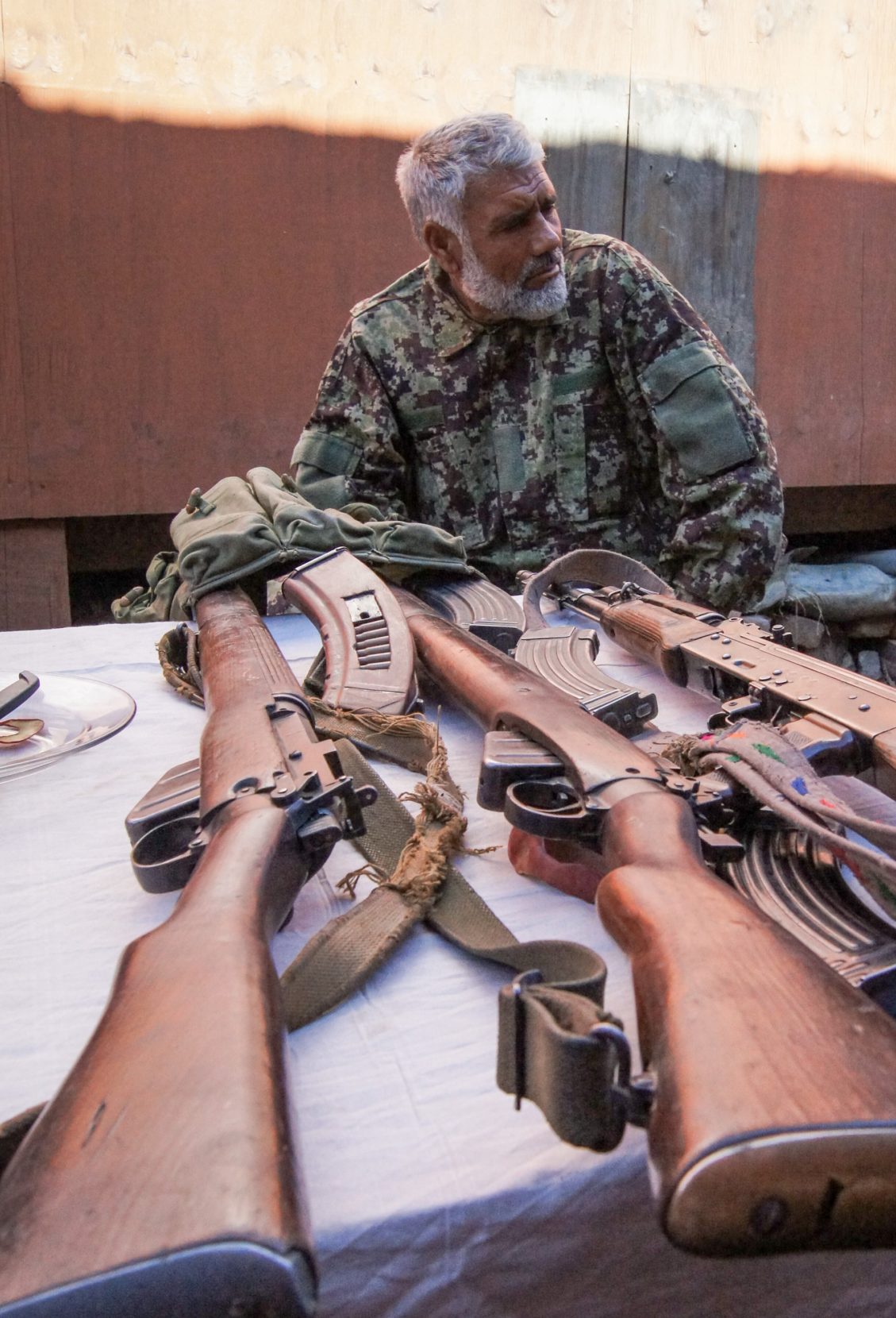
Officers of the Afghan National Army’s 201st Corps display weapons their troops seized during a 2013 raid in Kunar province’s Pech valley. Photo: Wesley Morgan.
But I was impressed to hear a teenage sergeant I interviewed privately through my interpreter strike a similar tone of assurance. “When we got here,” he told me, “the situation was worse. But we hurt the enemy and built more checkpoints.” Firefights with the Taliban, previously a daily occurrence, were now a weekly event.
~~
During the later years of U.S. involvement, when the mission shifted to training and advising, the drag-them-along, check-the-box, “put an Afghan face on it” approach became the exception, not the norm for American units.
It had been the norm from about 2006 to 2013, when the U.S. troop presence was largest — formative years for the huge panoply of Afghan security organizations that the U.S. and NATO created during that era.
Members of adviser teams like the ones I had visited in 2009 tended to be more generous about the abilities and promise of Afghan units than U.S. infantrymen, who had a hard time looking past their failings.
“Everyone wants to complain about them: ‘Oh, these guys can’t shoot, they can’t patrol,’” John Farris, a Marine captain who did a tour as an ANA adviser in the infamously violent Korengal Valley, told me. “But where were we when our army first started? It’s like having a baby and saying, ‘This baby’s stupid — he can’t even talk, he can’t even play sports.’ It’s going to take time.”
How much time, of course, was the question no one could answer.
~~
When push came to shove last summer, the ANA and the paramilitary police forces that fought alongside it collapsed. Friends and colleagues of mine captured snippets of this collapse during dangerous trips to places like Helmand and Kandahar on the Islamic Republic’s crumbling periphery. But the fastest collapse was in rural districts inaccessible to foreign media, where everything from desperate last stands to outright surrenders went undocumented, recorded at the U.S. embassy complex only as data points on a growing list of locations lost.
President Joe Biden’s assessment of the Afghan troops’ performance was unforgiving. “American troops cannot and should not be fighting in a war and dying in a war that Afghan forces are not willing to fight for themselves,” he said at the White House the day after Kabul’s fall. “We gave them every chance to determine their own future. What we could not provide them was the will to fight for that future.”
For many Americans I’ve spoken to since, Biden’s judgment is the bottom line: The Afghans didn’t fight for their country.
But what that speech ignored — and what even well-informed Americans seem to have forgotten — is the toll that years of brutal fighting had taken on Afghan security forces by the time the Trump administration’s Doha deal telegraphed the coming U.S. withdrawal and gave the Taliban an 18-month breather to prepare for it.
In all, some 2,400 American soldiers, sailors, airmen, and Marines lost their lives in Afghanistan over 20 years, and most of those losses during the 2009-2011 surge. I find that even if they can’t quote the specific number, their countrymen are familiar with that cost.
That as many as 9,000 Afghan soldiers and police were dying every year during the Islamic Republic’s twilight, on the other hand, tends to be new information.
And that the toll was even worse during the final summer — when parts of the Afghan army were putting down their weapons, but others were fighting to the death — seems hard for some Americans to believe. Perhaps that’s because it doesn’t square with the version they heard from their president, whose remarks about the lack of Afghan will to fight left out that 4,000 Afghan soldiers and police had just died fighting in the span of a few weeks.
~~
By 2017, the last time I went to Afghanistan, it had gotten harder for me to get out of Kabul and into the countryside. But I didn’t have to venture far beyond the city limits to see what I’d been unable to conceive of when I first visited the country: the beige hulks of U.S.-built Humvees, derelict on the roadsides, just like the Soviet ones. American troops hadn’t abandoned them there. And seeing them, it dawned on me that in most cases, the Soviet troops hadn’t abandoned their T-72s, BMPs, and BTRs on the battlefield either.
The rusting hulks of Soviet-built armored vehicles … when I saw them in Wardak and Helmand provinces on my first reporting trip to Afghanistan, in the spring of 2009, I felt sure that whatever the outcome for the United States in the country that had beaten the Soviet Union in the 1980s, it couldn’t possibly look like that.
Like the Soviets, who handed over thousands of tanks and troop carriers to a communist regime that they promised to keep propping up from afar, American troops had bequeathed all those Humvees to the army of a doomed government. The Afghan military and paramilitary troops had lost them as they fought a brutal, years-long, losing battle against the Taliban — one that most Americans would never give them credit for.
They were the vehicles not of a superpower, but of its vanished client state — evidence of the slow and bloody death that the Islamic Republic of Afghanistan and its brittle army had already been dying for years by the time of its final collapse in 2021.
The Afghan army that the United States and NATO built, then neglected for years in favor of fighting the Taliban themselves, is gone. In a country now ruled by its foes, the battered Humvees on the edges of Afghan highways will likely be the main physical monument to the life of suffering and valor that that army led.
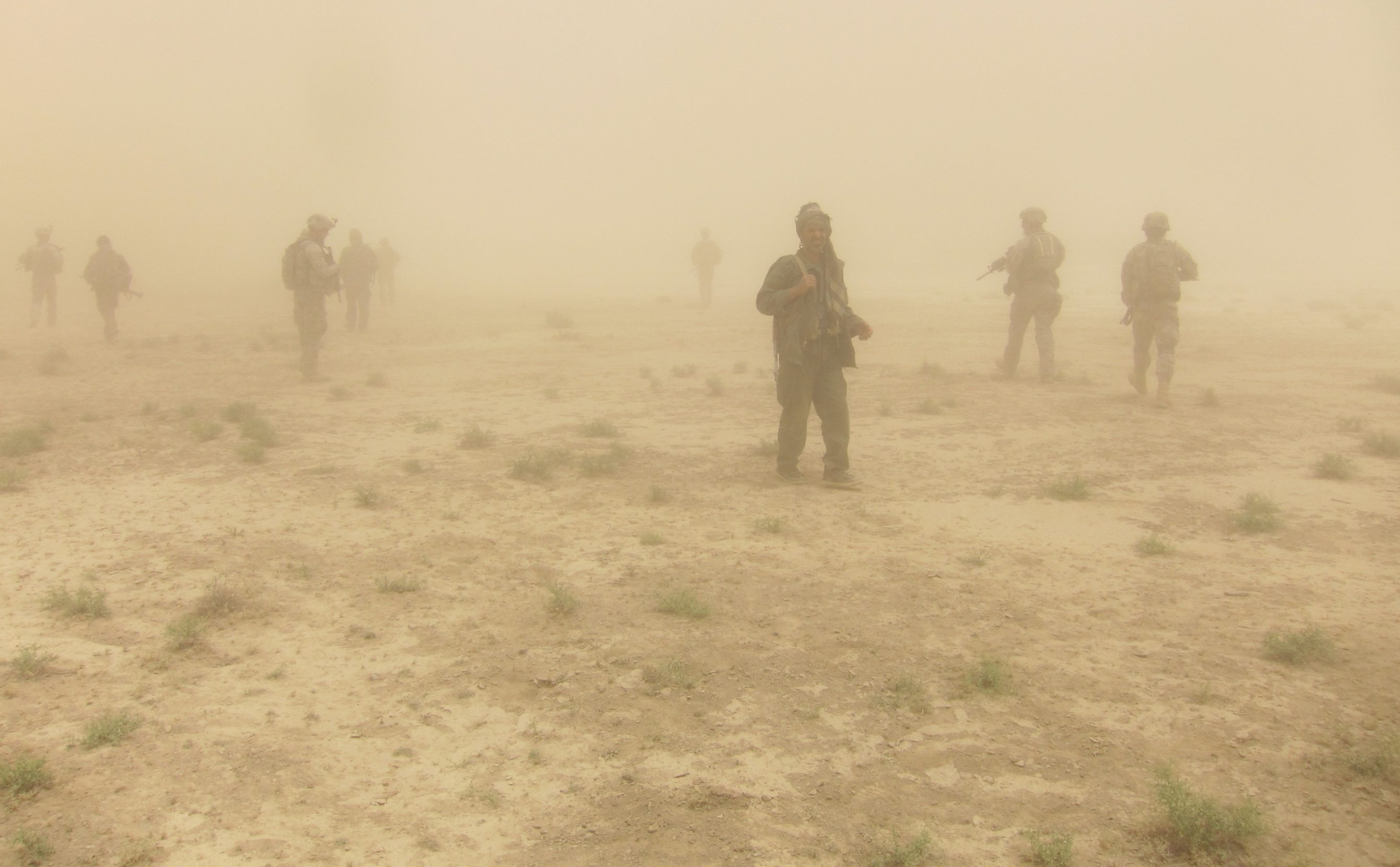
Blown by helicopters, a beige storm of sand and dust shrouds the silhouettes of an Afghan National Policeman (center) and a group of soldiers in Paktika province in 2010. Photo: Wesley Morgan.
Wesley Morgan
Wesley Morgan is a military-affairs reporter who has covered the U.S. wars in Afghanistan and Iraq since 2007. A native of the Boston area, he began embedding with combat units as a 19-year-old freelancer.


